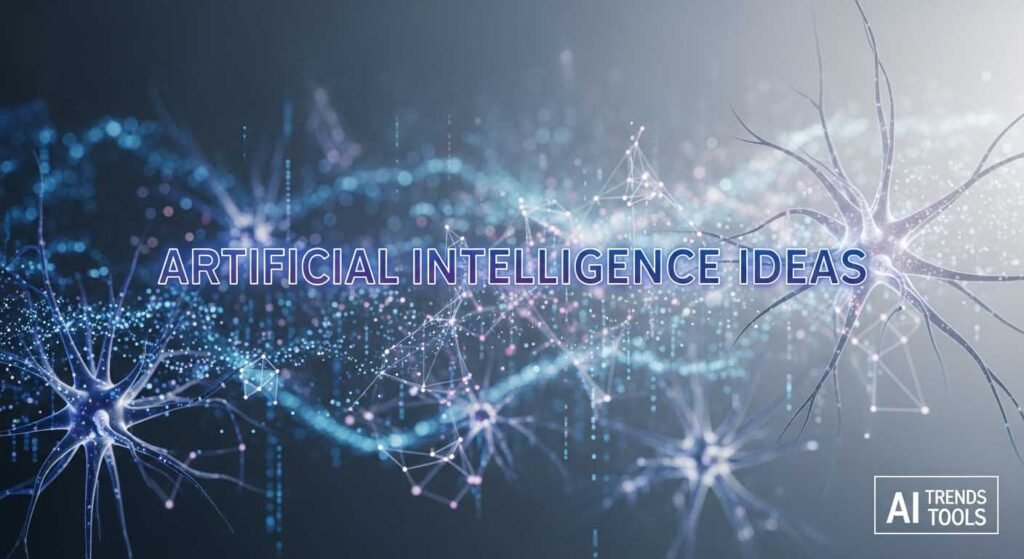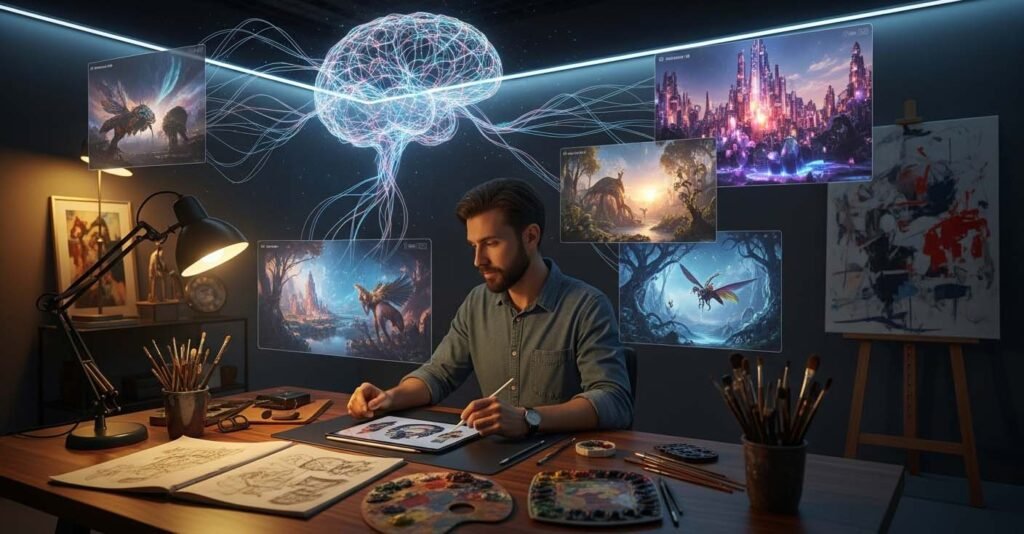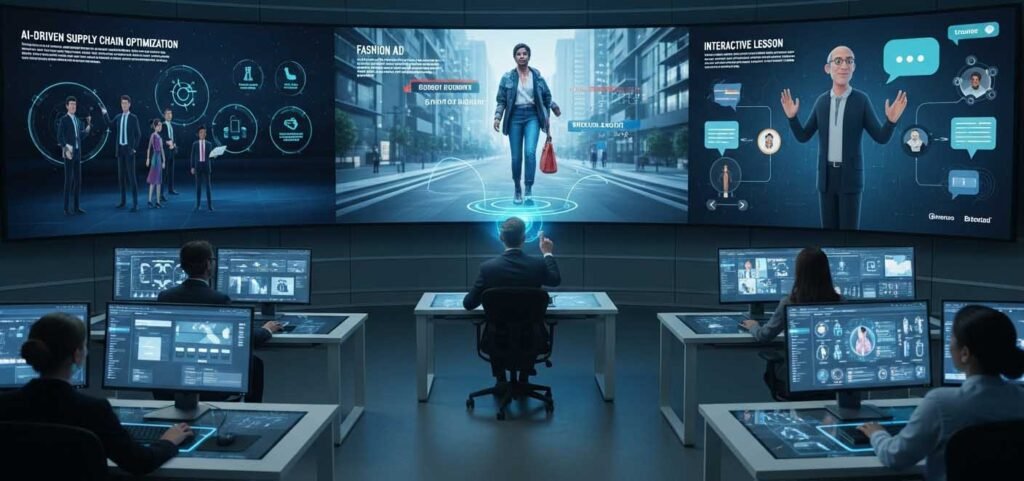Artificial Intelligence Ideas
Transforming Creativity, Video, and the Future of Innovation

Artificial intelligence (AI) is no longer a futuristic buzzword—it is the backbone of how creativity, communication, and business innovation are evolving in 2025. Today, Artificial intelligence Ideas are not abstract theories but practical blueprints that transform a single line of text into a video, a sketch into a finished design, or raw data into business insights.
From text-to-video platforms and AI-powered avatars to generative marketing campaigns and personalized learning systems, the speed of adoption is accelerating across industries. The latest Stanford AI Index 2025 shows a record surge in investment and enterprise adoption, while Harvard Business Review notes that over 65% of executives are actively embedding generative AI in daily workflows. This makes one thing clear: the organizations that can harness Artificial intelligence Ideas strategically will lead the next wave of growth and creativity.
This article provides a complete exploration of the ecosystem: how AI technologies amplify human creativity, revolutionize video production, reshape industries, and what businesses must know about ethics, risks, and implementation best practices.

Why “Artificial Intelligence Ideas” Matter Right Now
Defining “Artificial Intelligence Ideas” — From Concepts to Deployed Generative Systems
Artificial intelligence Ideas represent the practical application of generative AI systems to solve creative and business challenges. Once speculative, these ideas now drive real-world systems such as:
Text-to-video platforms like Runway and Pika Labs.
Multimodal assistants like OpenAI’s GPT-5 and Google Gemini.
Real-time avatars such as Nvidia’s Audio2Face.
Instead of being abstract “what ifs,” they are deployed creative engines transforming industries.
2024–2025 Snapshot: Adoption, Investment, and Real-World Impact
Investment: Global AI private investment surpassed $100 billion in 2025, doubling from 2023 levels.
Adoption: Over 60% of Fortune 500 companies report active use of generative AI in marketing and media.
Impact: Startups leveraging Artificial intelligence Ideas in video production cut costs by up to 80% compared to traditional pipelines.
Who Should Care — Creators, Marketers, Educators, Product Teams
Creators: Streamline idea generation, storyboarding, and editing.
Marketers: Scale hyper-personalized campaigns.
Educators: Deliver adaptive, student-specific content.
Product Teams: Prototype UX designs and onboarding flows with minimal resources.
Anyone tasked with turning ideas into impact needs to integrate AI into their toolkit.

The Generative AI Ecosystem — Key Technologies Powering New Ideas
Large Language Models (LLMs) and Multimodal Models — Idea Synthesis and Prompt Engineering
LLMs like GPT-5 and Claude are at the heart of Artificial intelligence Ideas. They synthesize information, brainstorm concepts, and draft first iterations of creative work. With multimodal evolution, these models now handle:
Text + image → illustrated stories.
Audio + video → voiceover plus animation.
Code + design → automated prototypes.
Prompt engineering has emerged as a professional skill—turning vague instructions into high-quality outputs.
Text-to-Video, Image, Audio, and Avatar Pipelines — What’s Possible in 2025
2025 tools enable:
Marketing: Instant explainer videos from scripts.
Education: Avatars that deliver lessons interactively.
Entertainment: AI-driven short films or trailers.
Meta’s Vibes now supports interactive video ads, while Nvidia’s Audio2Face brings avatars to life in real time.
Infrastructure and Compute Trends — GPUs, Open-Source Frameworks, and Cloud APIs
Key drivers include:
Hardware: Nvidia H200 GPUs optimized for generative AI.
Frameworks: Hugging Face and Stability AI open models.
APIs: Cloud-based access democratizes entry for startups.
This infrastructure underpins the scalability of Artificial intelligence Ideas across industries.
Creativity Amplified — How AI Generates and Enhances Ideas
Co-Creation Workflows: Prompt → Draft → Iteration
The AI-human workflow accelerates ideation:
Prompt: Input vision (e.g., “sci-fi city skyline at sunset”).
Draft: AI generates concept art or video.
Iteration: Human refines, adds narrative, and polishes.
This reduces production cycles from weeks to hours.
AI as Ideation Engine: Brainstorming, Storyboarding, and Rapid Prototyping
Examples of Artificial intelligence Ideas in action:
Writers test 20+ headline variations in seconds.
Designers generate concept art from sketches.
Filmmakers create storyboards for entire scenes.
Product teams build interactive prototypes overnight.
Evidence and Research: Impact on Quality and Productivity
Studies (HBR, 2025) show:
+40% productivity gains in creative teams using AI.
Higher-rated outputs from AI-assisted workers than control groups.
Improved brainstorming diversity, with AI generating unexpected but valuable perspectives.

AI Video Revolution — Text-to-Video, Avatars, and Real-Time Animation
Text-to-Video Tools and Use Cases
Artificial intelligence Ideas have democratized video:
Ads: TikTok/Instagram clips generated on demand.
Corporate: Training explainers, investor updates.
Education: Custom course modules.
AI-Driven Avatars and Audio-to-Animation
AI avatars enhance:
Customer service: 24/7 virtual assistants.
E-learning: Instructors delivering personalized lessons.
Entertainment: Virtual influencers with global reach.
Production Pipelines — Speed, Scale, and Cost
Comparison of traditional vs. AI-driven pipelines:
| Stage | Traditional Timeline | AI-Powered Timeline | Cost Reduction |
|---|---|---|---|
| Scriptwriting | 1–2 weeks | 1–2 hours | 90% |
| Storyboarding | 5–7 days | Same day | 80% |
| Video production | 4–6 weeks | 24–48 hours | 70–85% |
The scale of efficiency makes AI irresistible for businesses.
Practical Business Applications — Turning AI Ideas into Revenue
Marketing & Advertising: Hyper-Personalization
AI enables:
Ads tailored to user preferences in real time.
Dynamic campaign testing with hundreds of variations.
Localization into dozens of languages instantly.
Product & UX: Prototypes, Micro-Videos, Onboarding
Artificial intelligence Ideas help product teams by:
Generating micro-videos for features.
Building UX prototypes without designers.
Automating onboarding tutorials.
Internal Efficiency: Knowledge Synthesis & Meeting Recaps
Organizations leverage AI for:
Summarizing 50-page reports into 1-page briefs.
Generating meeting notes with action items.
Ranking and filtering idea submissions.
Read More : The 15+ Best AI Video Generators of 2025
Ethics, IP & Legal Challenges Around AI-Generated Ideas
Copyright, Ownership, and Legal Trends
Courts increasingly rule that AI-generated work needs human input for copyright. Businesses must define ownership policies for outputs.
Bias, Attribution, and Transparency
Bias risk: AI inherits dataset bias.
Solution: Human review + diverse training data.
Best practice: Label all AI-generated assets.
Governance & Policy
Strong governance frameworks include:
Audit trails.
Licensing agreements.
Clear disclosure policies.

Education & Skill Shifts — Preparing People to Work with AI Ideas
New Literacies: Promptcraft, Model Evaluation, Editing
Skills in demand:
Promptcraft (precision prompting).
Model evaluation (judging output accuracy).
Multimodal editing (combining text, video, audio).
Curriculum & Training
Universities integrating AI studios.
Bootcamps teaching applied generative AI.
Corporate L&D programs on AI productivity tools.
Job Roles Growing
AI Creative Producer
Prompt Engineer
AI Model Curator
These roles blend creative instincts with technical expertise.
Industry Deep Dives — How Sectors Apply AI Ideas
Entertainment & Gaming
Procedural world-building.
AI NPCs with real-time dialogue.
Virtual actors replacing extras.
Advertising & Media
Campaigns auto-generated and A/B tested at scale.
AI-enhanced localization.
Automated influencer partnerships.
Education, Healthcare, Enterprise
Adaptive video lessons.
Patient training simulations.
Enterprise knowledge hubs powered by AI.
Risks, Limits, and Where AI Ideas Fail
Common Failure Modes
Hallucinations (factually wrong outputs).
Low-fidelity images/videos.
Lack of coherence in long-form narratives.
Economic & Cultural Risks
Job displacement in creative industries.
Homogenization of cultural outputs.
Market power concentration in top AI firms.
Mitigations
Human-in-the-loop workflows.
Guardrails (content filters, fact-checking).
Regulatory frameworks for responsible AI.

Roadmap & Best Practices — Implementing AI Ideas in Your Organization
From Pilot to Production
Steps to follow:
Start small with pilot projects.
Measure ROI on speed, cost, quality.
Scale successful initiatives.
Tooling Stack Recommendations
Creators: MidJourney, Runway, Pika.
Product teams: Synthesia, Figma AI.
Technical leads: Hugging Face, Nvidia frameworks.
KPIs and Governance
Track:
Creative throughput (volume).
Engagement metrics (effectiveness).
Compliance adherence (risk management).
Conclusion — The Future of Artificial Intelligence Ideas (2026 and Beyond)
Emerging Trends
Expect:
Real-time multimodal agents.
Edge AI models running locally.
Deep personalization across all content.
Strategic Recommendations
Treat AI as co-creator, not competitor.
Balance experimentation with governance.
Invest in skills + literacy for teams.
Final Thought
Artificial intelligence Ideas represent the most transformative wave since the internet. The future belongs to organizations that can integrate these systems while maintaining human creativity, ethics, and originality. Those who adapt now will lead the cultural and business landscape of the next decade.
